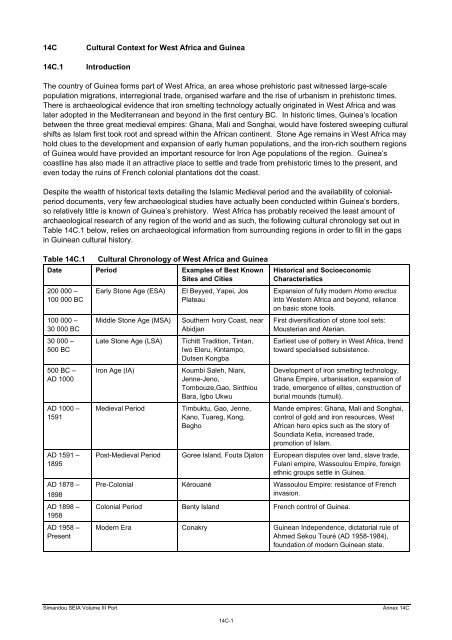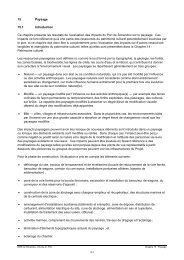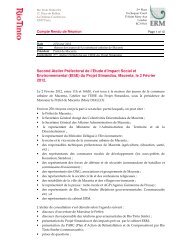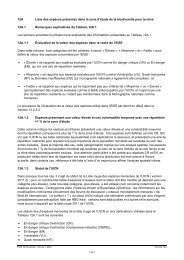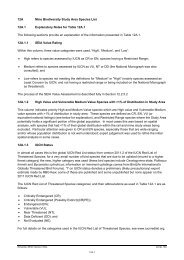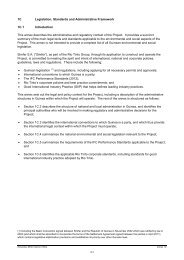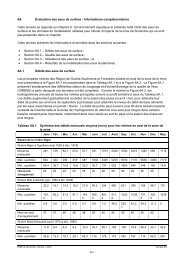Annex 14C: Cultural Context for West Africa and Guinea - Rio Tinto ...
Annex 14C: Cultural Context for West Africa and Guinea - Rio Tinto ...
Annex 14C: Cultural Context for West Africa and Guinea - Rio Tinto ...
You also want an ePaper? Increase the reach of your titles
YUMPU automatically turns print PDFs into web optimized ePapers that Google loves.
<strong>14C</strong> <strong>Cultural</strong> <strong>Context</strong> <strong>for</strong> <strong>West</strong> <strong>Africa</strong> <strong>and</strong> <strong>Guinea</strong><br />
<strong>14C</strong>.1 Introduction<br />
The country of <strong>Guinea</strong> <strong>for</strong>ms part of <strong>West</strong> <strong>Africa</strong>, an area whose prehistoric past witnessed large-scale<br />
population migrations, interregional trade, organised warfare <strong>and</strong> the rise of urbanism in prehistoric times.<br />
There is archaeological evidence that iron smelting technology actually originated in <strong>West</strong> <strong>Africa</strong> <strong>and</strong> was<br />
later adopted in the Mediterranean <strong>and</strong> beyond in the first century BC. In historic times, <strong>Guinea</strong>’s location<br />
between the three great medieval empires: Ghana, Mali <strong>and</strong> Songhai, would have fostered sweeping cultural<br />
shifts as Islam first took root <strong>and</strong> spread within the <strong>Africa</strong>n continent. Stone Age remains in <strong>West</strong> <strong>Africa</strong> may<br />
hold clues to the development <strong>and</strong> expansion of early human populations, <strong>and</strong> the iron-rich southern regions<br />
of <strong>Guinea</strong> would have provided an important resource <strong>for</strong> Iron Age populations of the region. <strong>Guinea</strong>’s<br />
coastline has also made it an attractive place to settle <strong>and</strong> trade from prehistoric times to the present, <strong>and</strong><br />
even today the ruins of French colonial plantations dot the coast.<br />
Despite the wealth of historical texts detailing the Islamic Medieval period <strong>and</strong> the availability of colonialperiod<br />
documents, very few archaeological studies have actually been conducted within <strong>Guinea</strong>’s borders,<br />
so relatively little is known of <strong>Guinea</strong>’s prehistory. <strong>West</strong> <strong>Africa</strong> has probably received the least amount of<br />
archaeological research of any region of the world <strong>and</strong> as such, the following cultural chronology set out in<br />
Table <strong>14C</strong>.1 below, relies on archaeological in<strong>for</strong>mation from surrounding regions in order to fill in the gaps<br />
in <strong>Guinea</strong>n cultural history.<br />
Table <strong>14C</strong>.1 <strong>Cultural</strong> Chronology of <strong>West</strong> <strong>Africa</strong> <strong>and</strong> <strong>Guinea</strong><br />
Date Period Examples of Best Known<br />
Sites <strong>and</strong> Cities<br />
200 000 –<br />
100 000 BC<br />
100 000 –<br />
30 000 BC<br />
30 000 –<br />
500 BC<br />
500 BC –<br />
AD 1000<br />
AD 1000 –<br />
1591<br />
AD 1591 –<br />
1895<br />
AD 1878 –<br />
1898<br />
AD 1898 –<br />
1958<br />
AD 1958 –<br />
Present<br />
Early Stone Age (ESA) El Beyyed, Yapei, Jos<br />
Plateau<br />
Middle Stone Age (MSA) Southern Ivory Coast, near<br />
Abidjan<br />
Late Stone Age (LSA) Tichitt Tradition, Tintan,<br />
Iwo Eleru, Kintampo,<br />
Dutsen Kongba<br />
Iron Age (IA) Koumbi Saleh, Niani,<br />
Jenne-Jeno,<br />
Tombouze,Gao, Sinthiou<br />
Bara, Igbo Ukwu<br />
Medieval Period Timbuktu, Gao, Jenne,<br />
Kano, Tuareg, Kong,<br />
Begho<br />
Sim<strong>and</strong>ou SEIA Volume III Port <strong>Annex</strong> <strong>14C</strong><br />
<strong>14C</strong>-1<br />
Historical <strong>and</strong> Socioeconomic<br />
Characteristics<br />
Expansion of fully modern Homo erectus<br />
into <strong>West</strong>ern <strong>Africa</strong> <strong>and</strong> beyond, reliance<br />
on basic stone tools.<br />
First diversification of stone tool sets:<br />
Mousterian <strong>and</strong> Aterian.<br />
Earliest use of pottery in <strong>West</strong> <strong>Africa</strong>, trend<br />
toward specialised subsistence.<br />
Development of iron smelting technology,<br />
Ghana Empire, urbanisation, expansion of<br />
trade, emergence of elites, construction of<br />
burial mounds (tumuli).<br />
M<strong>and</strong>e empires: Ghana, Mali <strong>and</strong> Songhai,<br />
control of gold <strong>and</strong> iron resources, <strong>West</strong><br />
<strong>Africa</strong>n hero epics such as the story of<br />
Soundiata Ketia, increased trade,<br />
promotion of Islam.<br />
Post-Medieval Period Goree Isl<strong>and</strong>, Fouta Djalon European disputes over l<strong>and</strong>, slave trade,<br />
Fulani empire, Wassoulou Empire, <strong>for</strong>eign<br />
ethnic groups settle in <strong>Guinea</strong>.<br />
Pre-Colonial Kérouané Wassoulou Empire: resistance of French<br />
invasion.<br />
Colonial Period Benty Isl<strong>and</strong> French control of <strong>Guinea</strong>.<br />
Modern Era Conakry <strong>Guinea</strong>n Independence, dictatorial rule of<br />
Ahmed Sekou Touré (AD 1958-1984),<br />
foundation of modern <strong>Guinea</strong>n state.
<strong>14C</strong>.2 Detailed <strong>Cultural</strong> Chronology (1)<br />
The following overview of cultural history <strong>and</strong> prehistory in <strong>West</strong> <strong>Africa</strong> was developed from st<strong>and</strong>ard<br />
published sources as part of the desk study <strong>for</strong> the cultural heritage assessment. It provides a context <strong>for</strong><br />
underst<strong>and</strong>ing <strong>and</strong> evaluating archaeological sites present in the study area. Archaeological sites <strong>and</strong><br />
historic monuments of the described prehistoric <strong>and</strong> historic periods are the tangible record of human<br />
developments <strong>and</strong> as such have both universal scientific <strong>and</strong> cultural value. <strong>Cultural</strong> Heritage sites are also<br />
sometimes associated with intangible aspects of <strong>Guinea</strong>’s traditional cultures <strong>and</strong> thus may hold deep<br />
significance to the local people.<br />
The following cultural chronology is divided into two broad periods: Prehistoric (200 000 BC – AD 1000) <strong>and</strong><br />
Historic (AD 1000 – Present). This division reflects the significant changes that occurred around AD 1000<br />
with the rise of the Ghana Empire (sub-Saharan <strong>Africa</strong>’s first empire), the influence of Islam, the appearance<br />
of detailed historical texts, <strong>and</strong> the general inclusion of <strong>West</strong> <strong>Africa</strong> into the global arena through European<br />
<strong>and</strong> Mediterranean trade networks.<br />
<strong>14C</strong>.2.1 Prehistoric Periods: 200 000 BC – AD 1 000<br />
<strong>14C</strong>.2.1.1 Early Stone Age (ESA): 200 000 – 100 000 BC<br />
This is the time period of the expansion of Homo erectus out of South <strong>and</strong> East <strong>Africa</strong> to other points on the<br />
globe, including <strong>West</strong> <strong>Africa</strong>. Remains from early Homo erectus are composed purely of stone tool<br />
technologies. Acheulian stone tools, which become wide-spread during the ESA, are found in fairly high<br />
densities in the western Sahara <strong>and</strong> are found in small numbers across <strong>West</strong> <strong>Africa</strong>. Plant <strong>and</strong> animal<br />
remains from these sites suggest a grassl<strong>and</strong> / scattered woodl<strong>and</strong> habitat (2) . Sites such as El Beyyed in<br />
Mauritania, with thous<strong>and</strong>s of stone bi-face tools, indicate that favourable Saharan climates may have<br />
supported stable populations over a long period of time.<br />
Oldowan lithics have been identified at a scatter of sites from the present <strong>for</strong>est region in Nigeria to the<br />
Sahara. At Yapei in Northern Ghana a number of pebble-choppers have been found which may suggest<br />
habitation dating to the Oldowan Period (ca. 2.5-1.5 m.y.ago (3) ). During this period, human societies<br />
probably practiced a range of scavenging <strong>and</strong> hunting / gathering activities. Population numbers were likely<br />
quite small.<br />
South of the Sahara, there are few ESA sites <strong>and</strong> none are known in Liberia, Sierra Leone, or in Lowl<strong>and</strong><br />
Ivory Coast or <strong>Guinea</strong> (4) Sites in Senegal (5) <strong>and</strong> southeastern Ghana <strong>and</strong> Togo (6) contain possible remains<br />
from the ESA. The best known area with ESA remains in western sub-Saharan <strong>Africa</strong> is the Jos Plateau in<br />
central Nigeria where hundreds of bifaces were discovered as a result of tin mining in alluvial deposits (7) .<br />
Overall, there is a low potential <strong>for</strong> the Project encountering ESA sites in <strong>Guinea</strong>.<br />
<strong>14C</strong>.2.1.2 Middle Stone Age (MSA): 100 000 – 30 000 BC<br />
Much like the ESA, most of the archaeological evidence <strong>for</strong> this period is found in the western Sahara. MSA<br />
remains are also identifiable by their specific stone tool technologies. Two types of stone tool technologies<br />
exist during the MSA: Mousterian <strong>and</strong> Aterian. These technologies are quite similar, most likely<br />
contemporary, <strong>and</strong> probably represent slight variations in hunting <strong>and</strong> other subsistence activities (8) . The<br />
(1) French or Anglo-American archaeologists who have worked in <strong>West</strong> <strong>Africa</strong> have employed different terminologies. This document<br />
uses the Anglo-American terminology.<br />
(2) Camps, G. (1974) Les Civilisations Pre-historiques de l'Afrique du Nord et du, Sahara. Paris: Doin<br />
(3) Swartz, B. K. (1972) An analysis <strong>and</strong> evaluation of the Yapei Pebble Tool industry, Ghana. Int. J. Afr. Hist. Stud. Notes Doc. 2:265-<br />
70<br />
(4) Swartz, B. K. (1980) The status of <strong>Guinea</strong> Coast paleoarchaeological knowledge as seen from Legon. See Ref. 15, pp. 37- 40<br />
(5) Descamps, C. (1978) Etat des connaiss-ances sur le Paleolithique au Senegal. Presented at Colloq. Assoc. Ouest-Afr Archaeol.,<br />
2nd, Bamako<br />
(6) Davies, 0. (1967) <strong>West</strong> <strong>Africa</strong> Be<strong>for</strong>e the Europeans. London: Methuen<br />
(7) Shaw, C. T. (1978) Nigeria. Its Archaeology <strong>and</strong> Early History. London: Thames & Hudson<br />
(8) Clark, J. D. (1982) The cultures of the Middle Palaeolithic / Middle Stone Age. See Ref. 48, pp. 248-340<br />
Sim<strong>and</strong>ou SEIA Volume III Port <strong>Annex</strong> <strong>14C</strong><br />
<strong>14C</strong>-2
differentiation of these tools is significant because it represents an early human innovation in <strong>West</strong> <strong>Africa</strong> as<br />
societies begin to diversify their toolsets to exploit a wider variety of environments <strong>and</strong> resources.<br />
MSA tools have been located in Nigeria (1) <strong>and</strong> Northern Cameroon (2) , but in secondary deposits, which<br />
makes them difficult to date. Better documented studies from southern Ivory Coast near Abidjan present<br />
unique deposits of MSA tools which provide important in<strong>for</strong>mation about the diversification of the early<br />
toolsets used by <strong>West</strong> <strong>Africa</strong>n people.<br />
MSA sites have a slightly higher potential of being uncovered in <strong>Guinea</strong> than ESA sites. However, these<br />
sites still pose an overall low potential risk of being found in the study area.<br />
<strong>14C</strong>.2.1.3 Late Stone Age (LSA): 30 000 – 500 BC<br />
As in the previous periods, most of the known LSA sites are located in the <strong>West</strong>ern Sahara. This period is<br />
significant archaeologically because it is the first period in <strong>West</strong> <strong>Africa</strong> where knowledge of the presence of<br />
humans is no longer based solely on stone tools; in this era, wide-spread rock art appears in the subcontinent<br />
(3) .<br />
The earliest part of the LSA (30 000 – 8 000 BC) is known as the pre-ceramic LSA. At around 20 000 BC,<br />
<strong>West</strong> <strong>Africa</strong> entered into a hyper-arid climatic period in which most of the population in <strong>West</strong> <strong>Africa</strong> would<br />
have probably lived south of 11 degrees north (4) , an area which includes <strong>Guinea</strong>. Between 10 000 <strong>and</strong><br />
8 000 BC, humid conditions returned. Archaeological traces are quite rare during the pre-ceramic LSA.<br />
The ceramic LSA (8 000 – 500 BC) witnesses a significant increase in recognised sites in <strong>West</strong> <strong>Africa</strong>. The<br />
earliest use of pottery in <strong>West</strong> <strong>Africa</strong> coincides with a humid period in the eighth <strong>and</strong> seventh millennia BC<br />
when now extinct Saharan lakes reached their highest Holocene levels. The earliest known examples of the<br />
ceramic LSA occur in the western Sahara along valleys or dry riverbeds, known as wadis in the central<br />
plateau (5) . The archaeologist’s reliance on stone tools persists, with the addition of grinding stones thought<br />
to be used <strong>for</strong> the processing of wild grains, a sure precursor to the later indigenous development of<br />
agriculture around 2 000 BC. High quantities of bone harpoons in the lower western Sahara near Timbuktu<br />
point to specialised fishing activities. Evidence <strong>for</strong> herding of Barbary sheep also occurs by 8 000 BC <strong>and</strong><br />
domestic cattle appear sometime between 5 000 <strong>and</strong> 2 500 BC, pointing to an ever increasing trend in<br />
specialised subsistence (6) . The development of cattle husb<strong>and</strong>ry required large amounts of water <strong>and</strong> so<br />
seasonal movement of populations became a necessary aspect in the lives of early <strong>West</strong> <strong>Africa</strong>ns (7) .<br />
Beginning around 2 500 BC, <strong>West</strong> <strong>Africa</strong> entered into another extremely arid period in which many previously<br />
inhabited sites were ab<strong>and</strong>oned, <strong>and</strong> those that remained tended to be located near permanent water<br />
sources such as rivers <strong>and</strong> near plateaus containing seasonal pools. During this period, the ancestors of the<br />
Ghana Empire in southern Mauritania, known as the Tichitt Tradition, developed a highly resilient society of<br />
cliff dwelling cities with lowl<strong>and</strong> resource gathering camps.<br />
Closer to <strong>Guinea</strong>, coastal sites from Mauritania, Senegal, Sierra Leone, Ivory Coast <strong>and</strong> Ghana during the<br />
LSA possess massive arca shell middens created between 4 500 <strong>and</strong> 1 500 BC. The best known of these<br />
sites are Tintan on the southern Mauritanian coast (8) <strong>and</strong> Gao Lagoon in Ghana (9) . Looking inward from the<br />
(1) Allsworth-Jones, P. (1980) - The Middle Stone Age industry from Zenabi, northern Nigeria. See Ref. 1, pp. 244-47; Allsworth-Jones,<br />
P. 1980. The Middle Stone Age north of the Jos Plateau: a preliminary report on the finds <strong>and</strong> their context. <strong>West</strong> Afr. J. Archaeol. 10:<br />
(2) Marliac, A. (1973) Prospection archeologique au Cameroun. Cah. ORSTOM (Ser. Sci. Hum.) 10:47-114<br />
(3) Mori, F. (1974) The earliest Saharan rock engravings. Antiquity 48:87-92<br />
(4) See: S. <strong>and</strong> R. McIntosh. (1983) Current Directions in <strong>West</strong> <strong>Africa</strong>n Prehistory. Annual Review of Anthropology. Vol 12 Pp. 215-<br />
258.<br />
(5) Maitre, J. P. (1976) Contribution' al a pre-histoire recente de l'Ahaggar dans son context Saharien. Bull. Inst. Fondam. Afr. Noire<br />
Ser. B 38:46, 716-89<br />
(6) Barich, B. (1974) La serie stratigraphica dell'uadi Ti-n-Torha. Origini 8:7-182<br />
(7) Clark, J. D. (1980) Human population <strong>and</strong> cultural adaptations in the Sahara <strong>and</strong> Nile during prehistoric times. In The Sahara <strong>and</strong><br />
the Nile, ed. M. A. Williams, H. Faure, pp. 527-82. Rotterdam: Bal-kema<br />
(8) Petit-Maire, N. (1979) Cardre ecologique et peuplement humain: le littoral ouest-Saharien depuis 10,000 ans. Anthropolo-gie<br />
83:69-82<br />
(9) Calvocoressi, D., David, N. (1979) A new survey of radiocarbon <strong>and</strong> thermo-luminescence dates <strong>for</strong> <strong>West</strong> <strong>Africa</strong>. J. Afr. Hist. 20:1-<br />
29<br />
Sim<strong>and</strong>ou SEIA Volume III Port <strong>Annex</strong> <strong>14C</strong><br />
<strong>14C</strong>-3
<strong>West</strong> <strong>Africa</strong>n coast to the <strong>for</strong>ested regions of Sierra Leone, Liberia <strong>and</strong> Nigeria, the LSA is represented by a<br />
microlithic tool technology which appears in the Nigerian <strong>for</strong>est around 9 200 BC (1) . The best known site <strong>for</strong><br />
the microlithic LSA is Iwo Eleru in central Nigeria. It is clear from the types of small lithic tools that these<br />
tools <strong>for</strong>m a totally different technology than what was being used in the more northern regions (2) . Other<br />
sites from the microlithic LSA come from the <strong>for</strong>est site of Shum Laka in Cameroon, the rock shelter sites of<br />
Bosumpra (3) <strong>and</strong> Kintampo (4) in Ghana, <strong>and</strong> the plateau site of Dutsen Kongba in central Nigeria (5) .<br />
The appearance of rounded bowls <strong>and</strong> grinding stones that are typical of more northern regions have been<br />
found in Liberia, Nigeria <strong>and</strong> Cameroon, suggesting a population migration from the Malian <strong>and</strong> Senegalese<br />
Sahel region to the <strong>for</strong>ested regions between <strong>Guinea</strong> <strong>and</strong> Nigeria, which probably occurred around 2 500 BC<br />
during the great arid phase described above. The technologies of these populations endured into the first<br />
millennium AD as evidenced by finds at rock shelter sites in the <strong>for</strong>ests of Liberia (6) <strong>and</strong> Sierra Leone (7) .<br />
Overall, there is a moderate potential in <strong>Guinea</strong> <strong>for</strong> archaeological sites from the late LSA since there are<br />
multiple instances of contemporary archaeological sites in neighbouring countries with similar <strong>for</strong>ested<br />
environments. The migration from the North around 2 500 BC would have increased the general population<br />
levels <strong>and</strong> the number of LSA sites in <strong>Guinea</strong>.<br />
<strong>14C</strong>.2.1.4 Iron Age (IA): 500 BC – AD 1 000<br />
Sub-Saharan <strong>Africa</strong>’s first civilisation develops in this period, marking a major turning point in the cultural<br />
history of the <strong>Africa</strong>n continent in general. During the IA, the first full-blown urban societies emerged in <strong>West</strong><br />
<strong>Africa</strong> <strong>and</strong> major trading relations across the entire subcontinent developed. St<strong>and</strong>ing armies in Mali <strong>and</strong><br />
Mauritania patrolled the l<strong>and</strong>scape <strong>and</strong> extracted taxes <strong>and</strong> goods from surrounding populations. Artistic<br />
styles developed <strong>and</strong> decorative ceramics <strong>and</strong> jewelry were offered to the dead as exotic grave goods.<br />
Thous<strong>and</strong>s of megalithic circles dot the l<strong>and</strong>scape from Senegal to eastern Mali <strong>and</strong> down to the northern<br />
part of <strong>Guinea</strong> at the archaeological site of Niani (8) . Walled cities have been found from Ghana to northern<br />
Mali <strong>and</strong> thous<strong>and</strong>s of tumuli can be found throughout the subcontinent.<br />
Unlike other parts of the world that slowly transitioned to iron-use though the usual trajectory of stonecopper-bronze-iron,<br />
<strong>West</strong> <strong>Africa</strong> jumps directly from the use of stone to iron tools. The rapid <strong>and</strong> expansive<br />
transition from stone to iron represents a sort of technological revolution which brought about significant<br />
accompanying developments in social structure <strong>and</strong> complexity of <strong>West</strong> <strong>Africa</strong>n prehistoric society. The<br />
origins of early iron technology in <strong>West</strong> <strong>Africa</strong> are not well known. There are three competing theories: 1) it<br />
was indigenously invented in Nigeria around 600 BC; 2) it was brought in across the Sahel from the Meore<br />
cultures from Sudan; or, 3) it was brought in from Phoenician traders from North <strong>Africa</strong>. Regardless of how<br />
the technology arrived, its first appearance in the archaeological record of <strong>West</strong> <strong>Africa</strong> is in the Nok Valley in<br />
Nigeria <strong>and</strong> northern Niger by 500 BC. Within two or three centuries most of <strong>West</strong> <strong>Africa</strong> had set aside their<br />
stone tools <strong>for</strong> more durable iron products.<br />
From 500 BC to about AD 500, an expansive increase in population <strong>and</strong> settlement size occurs, which is<br />
reflected in the density <strong>and</strong> cultural richness of archaeological remains. Some of the best known<br />
archaeological sites from this period come from the Middle Niger Delta in Mali. The impressive 15 metre tall<br />
tumuli near Timbuktu in the Malian Lakes region known as El-Oualedji contained an extremely rich burial<br />
chamber accompanied by human sacrifice, iron weaponry, exotic goods, <strong>and</strong> ceramics (9) . Just 50 km west,<br />
at the site of Tondidaro, dated to the 7 th century AD, massive tumuli are associated with megalithic circles<br />
carved with phallic <strong>and</strong> geometric motifs (10) . The site of Tombouze, 10 km from Timbuktu, is an urban site<br />
(1) Shaw, C. T. (1973) Finds at the Iwo Eleru rock shelter, western Nigeria. See Ref. 16, pp. 190-92<br />
(2) Shaw, C. T. (1978-1979) Holocene adaptations in <strong>West</strong> <strong>Africa</strong>: the Late Stone Age. Early Man News 3-4:51-81<br />
(3) Smith, A. B. (1975) Radiocarbon dates from Bosumpra Cave, Abetifi, Ghana. Proc. Prehist. Soc. 41:179-82<br />
(4) Flight, C. (1976) The Kintampo culture <strong>and</strong> its place in the economic prehistory of <strong>West</strong> <strong>Africa</strong>. See Ref. 46, pp. 211- 21<br />
(5) York, R. N. (1978) Excavations at Dutsen Kongba, Plateau State, Nigeria. <strong>West</strong> Afr. J. Archaeol. 8:139-163<br />
(6) Gabel, C. (1976) Microlithic occurrences in the Republic of Liberia. <strong>West</strong> Afr. J. Archaeol. 6:21-35<br />
(7) Atherton, J. H. (1972) Excavations at Kamabai <strong>and</strong> Yagala rock shelters, Sierra Leone. <strong>West</strong> Afr. J. Archaeol. 2:39- 74<br />
(8) Filipowiak, W. (1979) Etudes archeologiques sur la capital du Mali. Szczecin, mseum Narodowe.<br />
(9) Mauny, R. (1961) Tableau Geographique de l'Ouest <strong>Africa</strong>n au Moyen Age: d'Apres les Sources Ecrites, la Tradition et<br />
l'Archeologie. Mem. Inst. Fondam. Afr. Noire 61. Dakar: IFAN<br />
(10) ibid<br />
Sim<strong>and</strong>ou SEIA Volume III Port <strong>Annex</strong> <strong>14C</strong><br />
<strong>14C</strong>-4
measuring over 100 ha; a scale rarely reached by any prehistoric society worldwide (1) . Other important sites<br />
during this period include Jenne-Jeno (2) , Koumbi Saleh (the ancient capital of the Ghana Empire) (3) , Niani<br />
(the possible ancient capital of the Mali Empire in <strong>Guinea</strong>) (4) , Gao (the ancient capital of the Songhai<br />
Empire) (5) , Sinthiou Bara on the Senegal River (6) , <strong>and</strong> the expansive distribution of 6 800 known tumuli /<br />
monuments <strong>and</strong> 16 000+ megalithic stone circles in southern Senegal (7) . One of the best illustrations of the<br />
existence of an elite class during the Iron Age in <strong>West</strong> <strong>Africa</strong> comes from the site of Igbo Ukwu in eastern<br />
Nigeria (8) . Excavations uncovered an array of cast bronze vessels <strong>and</strong> finely crafted copper objects. One of<br />
the excavation units revealed the burial chamber of a high-ranking individual, whose regalia included a<br />
bronze staff <strong>and</strong> whisk, chased copper pectoral <strong>and</strong> crown, <strong>and</strong> over 100 000 glass beads. Wood from the<br />
burial chamber has been dated to the ninth century AD.<br />
Perhaps the most widely known civilisation of the IA is the ancient Ghana Empire located in southern<br />
Mauritania at Koumbi Saleh. Rising to power sometime around AD 700, Ghana attracted the attention of<br />
Islamic writers <strong>and</strong> travelers. Ghana is the first mention in any textual source of a <strong>West</strong> <strong>Africa</strong>n society.<br />
Ghana’s influence over the gold, slave <strong>and</strong> iron trade propelled <strong>West</strong> <strong>Africa</strong> onto the world stage.<br />
Overall, there is a high potential <strong>for</strong> discovering archaeological sites in the study area dating to the IA. The<br />
iron-rich southern regions of <strong>Guinea</strong> surely would have attracted the attention of Ancient Ghana among other<br />
iron using cultures in <strong>West</strong> <strong>Africa</strong>, <strong>and</strong> there are various known ancient iron smelting sites located within<br />
<strong>Guinea</strong>n borders. Further, the presence of thous<strong>and</strong>s of tumuli <strong>and</strong> megalithic circles in southern Senegal<br />
as well as the massive IA site of Niani in northern <strong>Guinea</strong> implies other instances of tumuli <strong>and</strong> settlements in<br />
the country are probable.<br />
<strong>14C</strong>.2.2 Historic Periods: AD 1 000 – Present<br />
<strong>14C</strong>.2.2.1 Medieval Period: AD 1 000 – 1591<br />
This period well known <strong>for</strong> the succession of three related M<strong>and</strong>e empires: Ghana, Mali <strong>and</strong> Songhai.<br />
Ghana, which had emerged in the IA, prospered through the 11 th century AD as it exp<strong>and</strong>ed its influence as<br />
far south as <strong>Guinea</strong>, <strong>and</strong> as far east as the Timbuktu area. Nomadic tribes of North <strong>Africa</strong> starting early on in<br />
the 9 th century <strong>and</strong> increasing at the end of the 10 th century gained control of the gold trade putting Ghana<br />
into decline. When Ghana collapsed in the mid13 th century, the Mali Empire arose after initial wars with the<br />
Soso tribes. The founder of the Mali Empire, Soundiata Ketia, <strong>for</strong>cefully combined the loose confederation of<br />
M<strong>and</strong>e states in <strong>West</strong> <strong>Africa</strong> under his rule. Much like the Ghana Empire, Mali’s source of wealth <strong>and</strong><br />
influence came from its control of trade in metals, goods <strong>and</strong> slaves from the southern regions of <strong>West</strong><br />
<strong>Africa</strong>. Its sphere of influence extended well beyond the northern border of <strong>Guinea</strong>, down to modern day<br />
Liberia <strong>and</strong> Sierra Leone. During this time, Timbuktu, Goa, Jenne <strong>and</strong> Niani (in <strong>Guinea</strong>) became powerful<br />
<strong>and</strong> influential cities. In the 15 th century AD the Songhai Empire, based in modern day Gao, rose up <strong>and</strong><br />
overthrew the Malian Empire. Trade was also important <strong>for</strong> the stability <strong>and</strong> power of this empire. Under this<br />
empire, Islam was actively promoted <strong>for</strong> the first time in <strong>West</strong> <strong>Africa</strong>. The Songhai Empire encompassed the<br />
largest amount of l<strong>and</strong> out of the three M<strong>and</strong>e empires <strong>and</strong> may have been the first to actually control the<br />
gold <strong>and</strong> iron sources to the south. In 1591, however, a Moroccan invasion of Timbuktu <strong>and</strong> other important<br />
cities effectively dissolved the Songhai Empire, ending the Medieval Period. Shortly thereafter, Portuguese<br />
traders <strong>and</strong> slavers set up an Atlantic shipping route from various points on the west coast, diminishing the<br />
importance of the trans-Saharan trade (9) .<br />
(1) Park, D.P. (2011) Climate Change, Human Response <strong>and</strong> the Origins of Urbanism at Timbuktu. Ph.D. Thesis, Yale University,<br />
Dept. Anthro.<br />
(2) McIntosh, S. K., McIntosh, R. J. (1980) Prehistoric Investigations in the Region of Jenne, Mali. Ox<strong>for</strong>d: BAR 2 vols.<br />
(3) Mauny, R. (1961) Tableau Geographique de l'Ouest <strong>Africa</strong>n au Moyen Age: d'Apres les Sources Ecrites, la Tradition et<br />
l'Archeologie. Mem. Inst. Fondam. Afr. Noire 61. Dakar: IFAN<br />
(4) Filipowiak, W. (1979) Etudes archeologiques sur la capital du Mali. Szczecin, mseum Narodowe.<br />
(5) Insoll, T. (1996) Iron Age Gao. BAR<br />
(6) Diop, C. A. (1977) Datations par la m6thode du radiocarbone, S6rie IV. Bull. Inst. Fondam. Afr. Noire Ser. B 39:461- 70<br />
(7) Martin V., Becker, C. (1974) Vestiges protohistoriques et occupation humaine au Senegal. Ann. Demogr. Hist., pp. 403-29<br />
(8) Shaw, C. T. (1970) Igbo Ukwu: An Account of Archaeological Discoveries in Eastern Nigeria. London: Faber & Fa-ber. 2 vols.<br />
(9) Levtzion, N. (1980) Ancient Ghana <strong>and</strong> Mali. Holmes <strong>and</strong> Meier Publishing.<br />
Sim<strong>and</strong>ou SEIA Volume III Port <strong>Annex</strong> <strong>14C</strong><br />
<strong>14C</strong>-5
The country of <strong>Guinea</strong> <strong>and</strong> surrounding regions would have acted as an extremely important transportation<br />
route between the Medieval Empires <strong>and</strong> the gold fields in northern Akanl<strong>and</strong>, located in modern-day Ghana.<br />
Between the famous gold trading cities of Begho in Ghana <strong>and</strong> Jenne in Mali lies the famed trading city of<br />
Kong (in northern Ivory Coast, close to the <strong>Guinea</strong> border) (1) . <strong>Guinea</strong>’s proximity to major Medieval empires<br />
<strong>and</strong> the presence of known sites from the period point to a high probability <strong>for</strong> Medieval period sites<br />
throughout <strong>Guinea</strong>, including large-scale settlements <strong>and</strong> especially trading outposts.<br />
<strong>14C</strong>.2.2.2 Post-Medieval Period: AD 1591 – 1895<br />
This is the first period in which there is substantial in<strong>for</strong>mation on the cultural events <strong>and</strong> groups within<br />
<strong>Guinea</strong>, which is probably the result of both European record keeping <strong>and</strong> local oral tradition that still exists<br />
in living memory. Immediately following the collapse of the <strong>West</strong> <strong>Africa</strong>n Medieval empires in 1591, the <strong>West</strong><br />
<strong>Africa</strong>n region began a long period of cultural <strong>and</strong> economic decline. Initially Portuguese slavers, <strong>and</strong> later<br />
the French <strong>and</strong> British all battled <strong>for</strong> control over costal ports. Goree Isl<strong>and</strong> off the coast of Dakar is perhaps<br />
the best known slaving port, over which European powers were constantly fighting <strong>for</strong> control. A number of<br />
known cultural heritage sites of historical importance are located near the Isl<strong>and</strong> of Benty on the <strong>Guinea</strong>n<br />
southern coast. They are associated with the slave trade <strong>and</strong> include a slaver’s outpost <strong>and</strong> a jail dating<br />
between the 18 th <strong>and</strong> 19 th centuries. Other historical sites near Benty include: 1) the imposing tomb of<br />
Monsieur Maridet (the first French plantation owner on Benty); 2) the white colonial cemetery; 3) the remains<br />
of a slave point of embarkation; <strong>and</strong>, 4) an underground slave prison, among a few other sites of interest.<br />
While regional trade in <strong>West</strong> <strong>Africa</strong> continued, it never reached the scale that it achieved in earlier periods. A<br />
short-lived Fulani Empire overran large areas of <strong>West</strong> <strong>Africa</strong>, but didn’t fully take control or assert its<br />
influence very far outside of captured cities. Over the period from the 14 th to 17 th centuries AD, the Dyula,<br />
Malinke <strong>and</strong> other M<strong>and</strong>ingo-related groups from Mali gradually settled in <strong>Guinea</strong>. From the 15 th to the 18 th<br />
centuries, the Fulani (aka Peul) settled in the Fouta Djallon <strong>and</strong> established it as a base <strong>for</strong> their pastoral<br />
lifestyle. During the 18 th <strong>and</strong> 19 th centuries, the Koniake, Toma <strong>and</strong> Guerze ethnic groups in <strong>Guinea</strong><br />
organised a medium-sized trading confederacy in slaves, ivory, cloth, iron, arms, <strong>and</strong> kola nuts. This<br />
economic activity largely came to an end by 1900, when the French established a presence in the <strong>Guinea</strong><br />
<strong>for</strong>est regions.<br />
Perhaps one of the more interesting historical figures during this time period was that of Samoury Touré,<br />
founder <strong>and</strong> ruler of the short-lived Wassoulou Empire (1878-1898). He is known <strong>for</strong> resisting the French<br />
penetration until his capture in 1882 (2) . Touré had an important base in the Project area town of Kérouané<br />
where there are historical sites associated with him. As of 2006 one of his descendants still lived in the<br />
town (3) .<br />
It is likely that there will be a Project Area contains a high number of habitation sites from this time period in<br />
<strong>Guinea</strong>, although probably not as many as from the earlier Medieval Period, since the practice of slaving<br />
may have reduced the population of the entire <strong>West</strong> <strong>Africa</strong> region by as much as one half.<br />
<strong>14C</strong>.2.2.3 Colonial Period: AD 1895 – 1958<br />
The post of Governor General of French <strong>West</strong> <strong>Africa</strong> was created in 1885 in Saint-Louis, Senegal. After<br />
finally defeating Samoury Touré in 1898, the French exp<strong>and</strong>ed their influence to control over <strong>Guinea</strong>.<br />
Although plantations were set up along the coast of <strong>Guinea</strong>, the French never gained full control over the<br />
interior <strong>for</strong>est regions. The remnants of these plantations can still be seen along the coast. Benty Isl<strong>and</strong> on<br />
the <strong>Guinea</strong>n south coast also has a colonial past with three docks built by the French. French colonialists<br />
also operated a number of plantations that produced fruit <strong>for</strong> export out of Benty.<br />
The port area of the Project Area in particular may have a higher potential <strong>for</strong> archaeological remains from<br />
the Colonial period because of the importance of sea trade during this period. If any of these historical<br />
structures remain in the port area, they would be expected to be above-ground <strong>and</strong> thus fairly easy to<br />
(1) T. Diabete, 'La region de Kong apres les fouilles archeologiques' (Paris thesis, I979)<br />
(2) Gann, L.H. <strong>and</strong> Duigan, Peter, Editors: Colonialism in <strong>Africa</strong>, 1870–1960, Vol. 1: The History <strong>and</strong> Politics of Colonialism 1870-1914.<br />
(1969) Cambridge University Press, Cambridge, UK<br />
(3) Etude de Caractéristique Sociale – Kérouané ville (2006) Synergy<br />
Sim<strong>and</strong>ou SEIA Volume III Port <strong>Annex</strong> <strong>14C</strong><br />
<strong>14C</strong>-6
identify. Aside from the coastal areas, there will probably be few archaeological sites from the French<br />
occupation of this period. Historical <strong>and</strong> ab<strong>and</strong>oned villages not associated with French occupation also<br />
probably exist in the <strong>for</strong>ested regions of the country <strong>and</strong> it should be relatively straight<strong>for</strong>ward to locate these<br />
by interviewing modern villagers.<br />
<strong>14C</strong>.2.2.4 The Modern Era: AD 1958 – Present<br />
Under the rule of Ahmed Sekou Touré (AD 1958-1984), <strong>Guinea</strong> remained isolated from the <strong>West</strong>, a fact that<br />
prevented western-trained archaeologists from working in the country. The Marxist-oriented government of<br />
Sekou Touré also discouraged the practice <strong>and</strong> teaching of indigenous belief systems, rituals <strong>and</strong> history (1) ,<br />
which in effect prevented the investigation into <strong>Guinea</strong>’s pre-Islamic period. So, while most of the major<br />
discoveries in <strong>West</strong> <strong>Africa</strong>n archaeology occurred in the 1970’s <strong>and</strong> 1980’s in places such as Sierra Leone,<br />
Liberia, Senegal <strong>and</strong> Mali, the country of <strong>Guinea</strong> remained terra incognita in terms of <strong>West</strong> <strong>Africa</strong>n<br />
archaeology <strong>and</strong> cultural heritage.<br />
While some of the local knowledge of the past was lost during the years following independence, a<br />
resurgence of traditional culture has occurred in <strong>Guinea</strong> in recent decades. Due to the general ubiquity of<br />
living cultural heritage in traditional societies <strong>and</strong> the expansive nature of the Project Area, there is a very<br />
high potential <strong>for</strong> living cultural heritage sites to be found within the Project Area beyond those already<br />
identified.<br />
(1) A <strong>Guinea</strong>n government report from 1979 on cultural policy, <strong>for</strong> example, condemns the “backward ways <strong>and</strong> customs” of the past,<br />
including such diverse characteristics as “religious mystification, polygamy, ignorance, alcoholism, dissolute living, lying, laziness, theft,<br />
the rural exodus, parasitism, intellectualism, the undue power of griots, etc”. See Pp. 74 of Ministry of Education <strong>and</strong> Culture of <strong>Guinea</strong>.<br />
(1979) <strong>Cultural</strong> Policy in the Revolution People’s Republic of <strong>Guinea</strong>. Paris.<br />
Sim<strong>and</strong>ou SEIA Volume III Port <strong>Annex</strong> <strong>14C</strong><br />
<strong>14C</strong>-7


